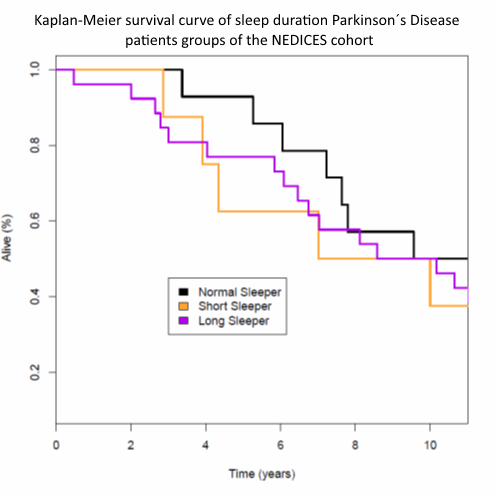Session Information
Date: Monday, October 8, 2018
Session Title: Parkinson's Disease: Non-Motor Symptoms
Session Time: 1:15pm-2:45pm
Location: Hall 3FG
Objective: To evaluate whether sleep duration (i) is associated with a subsequent risk of Parkinson’ disease (PD); (ii) affects mortality rates in PD patients, using data from a prospective cohort study.
Background: Sleep abnormalities in Parkinson’ disease (PD) (such as insomnia, sleep fragmentation or excessive daytime sleepiness) are common and result in disrupted sleep patterns affecting sleep duration. They are considered to be multifactorial and circadian dysfunction is likely to be one of the contributory mechanisms. Sleep duration abnormalities in late adulthood have been recently associated with increased risk of all-cause mortality and dementia. Excessive daytime sleepiness and chronic insomnia have been postulated as risk factors of PD in different populations. Circadian dysfunction has been suggested to affect the pathophysiological process of PD inducing alpha-synuclein deposition in animal models. We explored the effects of sleep duration on subsequent risk of PD and PD mortality in a cohort of elderly individuals.
Methods: Data from a population-based cohort of >65 year old individuals from Central Spain (NEDICES study) were used. A total of 2546 subjects without a diagnosis of PD or dementia were divided according to self-reported sleep duration in normal (6-8hours), short (<6h) or long sleepers (>8h) at baseline. PD incidence was assessed after a 3 year follow-up and its association to sleep duration was estimated using Kaplan-Meier curves, log-rank test and multivariate Cox and logistic regression models. Mortality data at 10 years of baseline were available for a total of 48 PD patients without dementia and its association with sleep duration was estimated.
Results: Cumulative incidence of PD was 0.45%, 1.11% and 0.71% for normal, short and long sleepers respectively. Using normal sleepers as reference, risk ratio of PD was 2.55 95%CI(0.64-10.15;p=0.17) for short sleepers and 1.56 95%C.I.(0.52-4.63;p=0.57) for long sleepers. Survival analysis did not show any significant difference among groups (log-rank test 1.37; p=0.505) and Kaplan-Meier curve is shown in Figure1. [figure1]
Conclusions: Short sleep duration may increase the risk of subsequent PD although results were not statistically significant due to the relatively small number of incident PD. Sleep duration does not seem associated with PD mortality. Further studies with larger cohorts and longer follow-up are warranted.
To cite this abstract in AMA style:
R. López-Blanco, A. Sánchez-Ferro, J. Benito-León, F. Bermejo-Pareja, E. de Pablo-Fernández. Association between sleep duration and subsequent risk of Parkinson´s disease and survival: Data from NEDICES study [abstract]. Mov Disord. 2018; 33 (suppl 2). https://www.mdsabstracts.org/abstract/association-between-sleep-duration-and-subsequent-risk-of-parkinsons-disease-and-survival-data-from-nedices-study/. Accessed January 4, 2026.« Back to 2018 International Congress
MDS Abstracts - https://www.mdsabstracts.org/abstract/association-between-sleep-duration-and-subsequent-risk-of-parkinsons-disease-and-survival-data-from-nedices-study/

